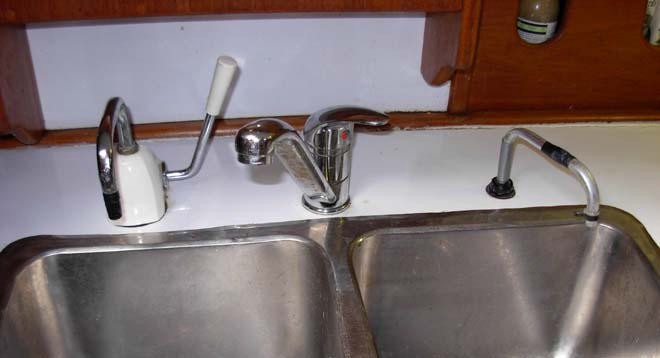Longer Cruising-How to Use Saltwater to Save Fresh
by Nancy Knudsen on 10 Jan 2007

Galley sink showing (from left) emergency hand pump fresh tap , hot and cold tap, foot pump seawater tap. SW
If you have a watermaker that produces 100 litres and hour, and you have a small crew, you will hardly need to economise on water. However, many sailing boats go on extended cruises without a water maker at all, and then the preservation of water supplies becomes simply good seamanship. The use of salt water to carry out many tasks, which the modern dweller takes for granted will be carried out with fresh, is an excellent way of preserving fresh water supplies.
On our yacht Blackwattle, we have a small watermaker, which makes around 15 litres an hour, and it suffices well enough for our purposes so that we have never found it necessary to replace it. We always preserve our fresh water by using salt where we can. However, the importance of finding ways to preserve our water supplies was brought home recently when the watermaker burst a hose and we were some 15 days from our next landfall.
Of course, using salt water in a marina or an anchorage where there are other boats around is a definite no-no, as the water is very likely to be polluted with all sorts of unimaginable nasties.
Where you are in clean salt water, having a salt water tap installed in the galley is a brilliant idea – be it a remote anchorage or the open sea.
The tasks for salt water are many and it’s a luxury to be able to use this water in unlimited quantities - here are just a few:
When fresh water is still plentiful:
· Use salt water instead of fresh to rinse all dishes etc before the wash-up.
· Wash vegetables like potatoes and carrots, before they are cooked.
· Boil eggs. (you’ll need to leave them slightly longer, as salt water boils quicker)
· Boil other vegetables in a combination of salt and fresh water, no need for adding salt.
· Peel onions under the running saltwater tap to prevent crying
· Wash hands in salt water then rinse off with fresh
When fresh water is not plentiful:
· Use salt water to wash all dishes, possibly rinsing them in fresh if you must (If the salt water is wonderful fresh ocean water, which is not very salty, we don’t even do this)
· Wipe down benches, except any areas of varnished wood.
· Boil all eggs and vegetables in salt water (specially ocean water, as it is not very salty)
· Rinse hands in salt water and forget the fresh.
Additional tips:
We keep a fresh water cloth and a salt water cloth on separate sides of the galley, and ‘never the ‘twain meet’ – the same with galley tea-towels!
Our salt-water tap is a foot pump – this means you can use both hands while pumping with your foot, very convenient.
When at sea, we rarely use the fresh water tap in the galley at all, except for drinking water.
IMPORTANT: Make very sure that the salt water is strictly restricted to the galley – getting salt water in any other part of the inside of the boat is to be avoided at all costs. When you LEAVE the galley, that is the time to rinse the salt water from your hands with a little fresh, or even a cloth damp with fresh water.
If you want to link to this article then please use this URL: www.sail-world.com/31103